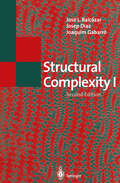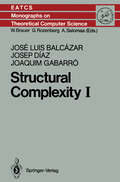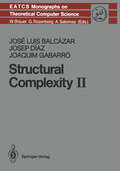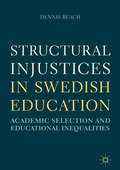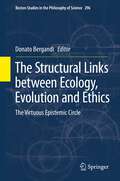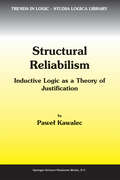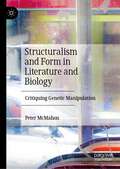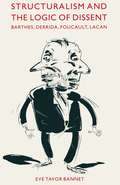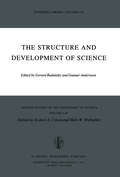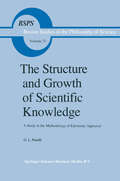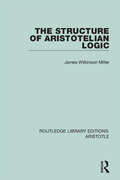- Table View
- List View
Structural Complexity I (Texts in Theoretical Computer Science. An EATCS Series)
by Jose L. Balcazar Josep Diaz Joaquim GabarroIn the six years since the first edition of this book was published, the field of Structural Complexity has grown quite a bit. However, we are keeping this volume at the same basic level that it had in the first edition, and the only new result incorporated as an appendix is the closure under complementation of nondeterministic space classes, which in the previous edition was posed as an open problem. This result was already included in our Volume II, but we feel that due to the basic nature of the result, it belongs to this volume. There are of course other important results obtained during these last six years. However, as they belong to new areas opened in the field they are outside the scope of this fundamental volume. Other changes in this second edition are the update of some Bibliograph ical Remarks and references, correction of many mistakes and typos, and a renumbering of the definitions and results. Experience has shown us that this new numbering is a lot more friendly, and several readers have confirmed this opinion. For the sake of the reader of Volume II, where all references to Volume I follow the old numbering, we have included here a table indicating the new number corresponding to each of the old ones.
Structural Complexity I (Monographs in Theoretical Computer Science. An EATCS Series #11)
by Jose L. Balcazar Josep Diaz Joaquim GabarroSince the achievement of a fonnal definition of the concept of "algorithm", the Mathematical Theory of Computation has developed into a broad and rich discipline. The notion of "complexity of an algorithm" yields an important area of research, known as Complexity Theory, that can be approached from several points of view. Some of these are briefly discussed in the Introduction and, in particular, our view of the "Structural" approach is outlined there. We feel the subject is mature enough to permit collecting and interrelating many of the results in book fonn. Let us point out that a substantial part of the knowledge in Structural Complexity Theory can be found only in specialized journals, symposia proceedings, and monographs like doctoral dissertations or similar texts, mostly unpublished. We believe that a task to be done soon is a systematization of the interconnections between all the research lines; this is a serious and long task. We hope that the two volumes of this book can serve as a starting point for this systematization process.
Structural Complexity II (Monographs in Theoretical Computer Science. An EATCS Series #22)
by Jose L. Balcazar Josep Diaz Joaquim GabarroThis is the second volume of a two volume collection on Structural Complexity. This volume assumes as a prerequisite knowledge about the topics treated in Volume I, but the present volume itself is nearly self-contained. As in Volume I, each chapter of this book ends with a section entitled "Bibliographical Remarks", in which the relevant references for the chapter are briefly commented upon. These sections might also be of interest to those wanting an overview of the evolution of the field, as well as relevant related results which are not included in the text. Each chapter includes a section of exercises. The reader is encouraged to spend some time on them. Some results presented as exercises are occasionally used later in the text. A reference is provided for the most interesting and for the most useful exercises. Some exercises are marked with a • to indicate that, to the best knowledge of the authors, the solution has a certain degree of difficulty. Many topics from the field of Structural Complexity are not treated in depth, or not treated at all. The authors bear all responsibility for the choice of topics, which has been made based on the interest of the authors on each topic. Many friends and colleagues have made suggestions or corrections. In partic ular we would like to express our gratitude to Richard Beigel, Ron Book, Rafael Casas, Jozef Gruska, Uwe Schoning, Pekka Orponen, and Osamu Watanabe.
Structural Injustice: Power, Advantage, and Human Rights
by Madison Powers Ruth FadenMadison Powers and Ruth Faden here develop an innovative theory of structural injustice that links human rights norms and fairness norms. Norms of both kinds are grounded in an account of well-being. Their well-being account provides the foundation for human rights, explains the depth of unfairness of systematic patterns of disadvantage, and locates the unfairness of power relations in forms of control some groups have over the well-being of other groups. They explain how human rights violations and structurally unfair patterns of power and advantage are so often interconnected. Unlike theories of structural injustice tailored for largely benign social processes, Powers and Faden's theory addresses typical patterns of structural injustice-those in which the wrongful conduct of identifiable agents creates or sustains mutually reinforcing forms of injustice. These patterns exist both within nation-states and across national boundaries. However, this theory rejects the claim that for a structural theory to be broadly applicable both within and across national boundaries its central claims must be universally endorsable. Instead, Powers and Faden find support for their theory in examples of structural injustice around the world, and in the insights and perspectives of related social movements. Their theory also differs from approaches that make enhanced democratic decision-making or the global extension of republican institutions the centerpiece of proposed remedies. Instead, the theory focuses on justifiable forms of resistance in circumstances in which institutions are unwilling or unable to address pressing problems of injustice. The insights developed in Structural Injustice will interest not only scholars and students in a range of disciplines from political philosophy to feminist theory and environmental justice, but also activists and journalists engaged with issues of social justice.
STRUCTURAL INJUSTICE C: Power, Advantage, and Human Rights
by Madison Powers Ruth FadenMadison Powers and Ruth Faden here develop an innovative theory of structural injustice that links human rights norms and fairness norms. Norms of both kinds are grounded in an account of well-being. Their well-being account provides the foundation for human rights, explains the depth of unfairness of systematic patterns of disadvantage, and locates the unfairness of power relations in forms of control some groups have over the well-being of other groups. They explain how human rights violations and structurally unfair patterns of power and advantage are so often interconnected. Unlike theories of structural injustice tailored for largely benign social processes, Powers and Faden's theory addresses typical patterns of structural injustice-those in which the wrongful conduct of identifiable agents creates or sustains mutually reinforcing forms of injustice. These patterns exist both within nation-states and across national boundaries. However, this theory rejects the claim that for a structural theory to be broadly applicable both within and across national boundaries its central claims must be universally endorsable. Instead, Powers and Faden find support for their theory in examples of structural injustice around the world, and in the insights and perspectives of related social movements. Their theory also differs from approaches that make enhanced democratic decision-making or the global extension of republican institutions the centerpiece of proposed remedies. Instead, the theory focuses on justifiable forms of resistance in circumstances in which institutions are unwilling or unable to address pressing problems of injustice. The insights developed in Structural Injustice will interest not only scholars and students in a range of disciplines from political philosophy to feminist theory and environmental justice, but also activists and journalists engaged with issues of social justice.
Structural Injustices in Swedish Education: Academic Selection and Educational Inequalities
by Dennis BeachWhile Sweden is often viewed as a benchmark for equality within education, this book examines this assumption in greater depth. The author argues that Sweden’s education system – even prior to the global spread of neoliberalism in education, meta-policies and privatization – was never particularly equal. Instead, what became apparent was a system that offered advantages to the upper social classes under a sheen of meritocracy and tolerable inequalities. Combining ethnographic and meta-ethnographic methodologies and analyses, the author examines the phenomenon of structural injustice in the Swedish education system both vertically and diachronically across a period of intensive transformation and reform. This revealing volume offers a mode of engagement that will be of value and interest to researchers and students of injustices within education, as well as policy makers and practitioners.
The Structural Links between Ecology, Evolution and Ethics: The Virtuous Epistemic Circle (Boston Studies in the Philosophy and History of Science)
by Donato BergandiEvolutionary biology, ecology and ethics: at first glance, three different objects of research, three different worldviews and three different scientific communities. In reality, there are both structural and historical links between these disciplines. First, some topics are obviously common across the board. Second, the emerging need for environmental policy management has gradually but radically changed the relationship between these disciplines. Over the last decades in particular, there has emerged a need for an interconnecting meta-paradigm that integrates more strictly evolutionary studies, biodiversity studies and the ethical frameworks that are most appropriate for allowing a lasting co-evolution between natural and social systems. Today such a need is more than a mere luxury, it is an epistemological and practical necessity.
Structural Rationality and Other Essays on Practical Reason (Theory and Decision Library A: #52)
by Julian Nida-RümelinIn this book, the author shows that it is necessary to enrich the conceptual frame of the theory of rational choice beyond consequentialism. He argues that consequentialism as a general theory of rational action fails and that this does not force us into the dichotomy teleology vs deontology. The unity of practical reason can be saved without consequentialism. In the process, he presents insightful criticism of standard models of action and rational choice. This will help readers discover a new perspective on the theory of rationality.The approach is radical: It transcends the reductive narrowness of instrumental rationality without denying its practical impact. Actions do exist that are outlined in accordance to utility maximizing or even self-interest maximizing. Yet, not all actions are to be understood in these terms. Actions oriented around social roles, for example, cannot count as irrational only because there is no known underlying maximizing heuristic. The concept of bounded rationality tries to embed instrumental rationality into a form of life to highlight limits of our cognitive capabilities and selective perceptions. However, the agent is still left within the realm of cost-benefit-reasoning. The idea of social preferences or meta-preferences cannot encompass the plurality of human actions. According to the author they ignore the plurality of reasons that drive agency. Hence, they coerce agency in fitting into a theory that undermines humanity. His theory of structural rationality acknowledges lifeworld patterns of interaction and meaning.
Structural Realism: Structure, Object, and Causality (The Western Ontario Series in Philosophy of Science #77)
by Elaine Landry and Dean RicklesStructural realism has rapidly gained in popularity in recent years, but it has splintered into many distinct denominations, often underpinned by diverse motivations. There is, no monolithic position known as ‘structural realism,’ but there is a general convergence on the idea that a central role is to be played by relational aspects over object-based aspects of ontology. What becomes of causality in a world without fundamental objects? In this book, the foremost authorities on structural realism attempt to answer this and related questions: ‘what is structure?’ and ‘what is an object?’ Also featured are the most recent advances in structural realism, including the intersection of mathematical structuralism and structural realism, and the latest treatments of laws and modality in the context of structural realism. The book will be of interest to philosophers of science, philosophers of physics, metaphysicians, and those interested in foundational aspects of science.
Structural Reliabilism: Inductive Logic as a Theory of Justification (Trends in Logic #16)
by P. KawalecKawalec's monograph is a novel defence of the programme of inductive logic, developed initially by Rudolf Carnap in the 1950s and Jaakko Hintikka in the 1960s. It revives inductive logic by bringing out the underlying epistemology. The main strength of the work is its link between inductive logic and contemporary discussions of epistemology. Through this perspective the author succeeds to shed new light on the significance of inductive logic. The resulting structural reliabilist theory propounds the view that justification supervenes on syntactic and semantic properties of sentences as justification-bearers. The claim is made that this sets up a genuine alternative to the prevailing theories of justification. Kawalec substantiates this claim by confronting structural reliabilism with a number of epistemological problems. Kawalec writes in a clear manner, makes his theses and arguments explicit, and gives ample bibliographical references.
The Structural Transformation of the Public Sphere: An Inquiry Into a Category of Bourgeois Society
by Jürgen HabermasThis major work retraces the emergence and development of the Bourgeois public sphere - that is, a sphere which was distinct from the state and in which citizens could discuss issues of general interest. In analysing the historical transformations of this sphere, Habermas recovers a concept which is of crucial significance for current debates in social and political theory. Habermas focuses on the liberal notion of the bourgeois public sphere as it emerged in Europe in the early modern period. He examines both the writings of political theorists, including Marx, Mill and de Tocqueville, and the specific institutions and social forms in which the public sphere was realized. This brilliant and influential work has been widely recognized for many years as a classic of contemporary social and political thought, of interest to students and scholars throughout the social sciences and humanities.
The Structural Transformation of the Public Sphere: An Inquiry Into a Category of Bourgeois Society
by Jürgen HabermasThis major work retraces the emergence and development of the Bourgeois public sphere - that is, a sphere which was distinct from the state and in which citizens could discuss issues of general interest. In analysing the historical transformations of this sphere, Habermas recovers a concept which is of crucial significance for current debates in social and political theory. Habermas focuses on the liberal notion of the bourgeois public sphere as it emerged in Europe in the early modern period. He examines both the writings of political theorists, including Marx, Mill and de Tocqueville, and the specific institutions and social forms in which the public sphere was realized. This brilliant and influential work has been widely recognized for many years as a classic of contemporary social and political thought, of interest to students and scholars throughout the social sciences and humanities.
Structural Violence: The Makings of Settler Colonial Impunity
by Elena Ru?zEnduring social inequalities in settler colonial societies are not an accident. They are produced and maintained by the self-repairing structural features and dynastic character of systemic racism and its intersecting oppressions. Using methods from diverse anticolonial liberation movements and systems theory, Structural Violence theorizes the existence of adaptive and self-replicating historical formations that underwrite cultures of violence in settler colonial societies. Corresponding epistemic forces tied to profit and wealth accumulation for beneficiary groups often go untracked. The account offered here argues that these epistemic forces play a central role in producing and maintaining massive health inequalities and the maldistribution of disease burdens?including those associated with sexual violence?for marginalized populations. It upends the widespread view that structural racism can be dismantled without addressing gendered violence. It also advocates for a theory of change rooted in reparative action and models of structural competency that respond to the built-in design of structural violence and the ecosystems of impunity that allow it to thrive.
Structural Violence: The Makings of Settler Colonial Impunity
by Elena Ru?zEnduring social inequalities in settler colonial societies are not an accident. They are produced and maintained by the self-repairing structural features and dynastic character of systemic racism and its intersecting oppressions. Using methods from diverse anticolonial liberation movements and systems theory, Structural Violence theorizes the existence of adaptive and self-replicating historical formations that underwrite cultures of violence in settler colonial societies. Corresponding epistemic forces tied to profit and wealth accumulation for beneficiary groups often go untracked. The account offered here argues that these epistemic forces play a central role in producing and maintaining massive health inequalities and the maldistribution of disease burdens?including those associated with sexual violence?for marginalized populations. It upends the widespread view that structural racism can be dismantled without addressing gendered violence. It also advocates for a theory of change rooted in reparative action and models of structural competency that respond to the built-in design of structural violence and the ecosystems of impunity that allow it to thrive.
Structuralism: Moscow-Prague-Paris (Synthese Library #67)
by J.M. BroekmanThe use of the word 'structuralism', not only as a title for the present book but also as a valuable indication for outstanding philosophical and cultural developments of our century, may embarrass the English reader. The same might be the case regarding some of the philosophical thoughts developed in connexion with this structuralism. Emphasis is namely not on a set of technical operations using ideas and conceptions closely linked up with 'structural' or 'systematical' analyses, system and in formation theories, biology, psychology and even literary criticism. On the contrary, the concept of structuralism here defmitely refers to a holistic approach, not unlike existentialism or phenomenology. Many philosophical implications of this structuralism are however quite different from those contained in existential philosophies. The first difference applies to philosophy itself: no existential thinker will doubt or deny that the thoughts developed are genuine philoso phical thoughts. Structuralism however does not take that decision before hand, and thus no longer restricts itself to the traditionallaws and habits of philosophical reasoning. It presents itself on the one hand as a holistic attempt to interpret reality among lines of philosophical argumentation, bu t tries to do so without the decision that this argumentation leads to philoso phy. Structuralism therefore presents itself as a specific activity, a modus operandi in reality itself.
Structuralism and Form in Literature and Biology: Critiquing Genetic Manipulation
by Peter McMahonThe book considers biology in parallel with philosophical structuralism in order to argue that notions of form in the organism are analogous to similar ideas in structuralist philosophy and literary theory. This analogy is then used to shed light on debates among biological scientists from the turn of the 19th century to the present day, including Cuvier, Geoffroy Saint-Hilaire, Dawkins, Crick, Goodwin, Rosen and West-Eberhard. The book critiques the endorsement of genetic manipulation and bioengineering as keys to solving agricultural and environmental problems, suggesting that alternative models have been marginalized in the promotion of this discourse. Drawing from the work of philosophers including Cassirer, Saussure, Jakobson and Foucault the book ultimately argues that methods based on agroecology, supported by molecular applications (such as marker-assisted selection, MAS), can both advance agricultural development and remain focused on the whole organism.
Structuralism and the Logic of Dissent: Barthes, Derrida, Foucault, Lacan
by Eve Tavor BannetStructuralism and the Logic of Dissent is a fascinating and lucid exploration of the seminal writings of four eminent French structuralists that sheds new light on influential theoretical texts. Eve Tavor Bannet discusses the work of Barthes, Derrida, Foucault, and Lacan as coherent philosophical fictions, showing their contradictory political, social, and pedagogical implications and their complex historicity.
Structure and Agent in the Scientific Diplomacy of Climate Change: An Empirical Case Study of Science-Policy Interaction in the Intergovernmental Panel on Climate Change (Advances in Global Change Research #5)
by T. SkodvinResearch input constitutes a key component in the development of international environmental regime formation. Science-policy interaction is, however, complex and difficult, particularly because it is an encounter between two distinct systems of behaviour: the scientific ideal of impartiality and disinterestedness and the political reality of interest realisation and strategic behaviour. This study analyses the extent to which and how the institutional framework within which the science-policy dialogue takes place - through conscious design - can be utilised as an instrument to handle obstacles and barriers immanent of science-policy interaction and thereby serve as an instrument to enhance the effectiveness of the dialogue. Also, the impact of actor behaviour, particularly behaviour taking the form of leadership performance, is investigated. This book provides a detailed and in-depth empirical study of science-policy interaction in the Intergovernmental Panel on Climate Change (IPCC) from its establishment in 1988, to the provision of the Second IPCC Assessment Report in 1995. The main focus of the empirical investigation is on Working Group I of the IPCC.
The Structure and Development of Science (Boston Studies in the Philosophy and History of Science #59)
by Gerard Radnitzky and Gunnar AnderssonTIus is the second, and fmal, volume to derive from the exciting Kronberg conference of 1975, and to show the intelligent editorial care of Gerard Radnitzky and Gunnar Andersson that was so evident in the first book, Progress and Rationality in Science (Boston Studies in the Philosophy of Science, Vol. 58). Together they set forth central themes in current history and philosophy of the sciences, and in particular they will be seen as also providing obbligatos: research programs, metaphysical inevitabilities, methodological options, logical constraints, historical conjectures. Boston University Center for the R. S. COHEN Philosophy and History of Science M. W. WARTOFSKY July 1979 T T ABLE OF CONTENTS v EDITORIAL EDITORIAL PREFACE PREFACE ix PREFACE PREFACE INTRODUCTION GUNNAR ANDERSSON / Presuppositions, Problems,Progress 3 PART I: METAPHYSICS AND THE DEVELOPMENT OF SCIENCE NICHOLAS RESCHER / Some Issues Regarding the Completeness of Science and the limits of Scientific Knowledge 19 MAX JAMMER / A Consideration of the Philosophical Implications of the New Physics 41 PAUL FEYERABEND / Dialogue on Method 63 PETER HODGSON / Presuppositions and limits of Science 133 PART II: RESEARCH PROGRAMS AND THE DEVELOPMENT OF SCIENCE WOLFGANG STEGMULLER / A Combined Approach to the Dynam ics of Theories. How to Improve Historical Interpretations of Theory Change by Applying Set Theoretical Structures 151 JOSEPH J. KOCKELMANS / Reflections on Lakatos' Methodology of Scientific Research Programs 187 P A TRICK A.
Structure and Diversity: Studies in the Phenomenological Philosophy of Max Scheler (Phaenomenologica #141)
by E. KellyFOUNDATIONALISM IN PHILOSOPHY n his autobiographical work, The Education of Henry Adams, this I brooding and disillusioned offspring of American presidents confronted, at age sixty, his own perplexity concerning the new scientific world-view that was emerging at the end of the century. He noted that the unity of things, long guaranteed morally by the teachings of Christianity and scientifically by the Newtonian world-view, was being challenged by a newer vision of things that found only incomprehensible multiplicity at the root of the world: What happened if one dropped the sounder into the ab yss-let it go-frankly gave up Unity altogether? What was Unity? Why was one to be forced to affirm it? Here every body flatly refused help. . . . [Adams] got out his Descartes again; dipped into his Hume and Berkeley; wrestled anew with his Kant; pondered solemnly over his Hegel and Scho penhauer and Hartmann; strayed gaily away with his Greeks-all merely to ask what Unity meant, and what happened when one denied it. Apparently one never denied it. Every philosopher, whether sane or insane, naturally af firmed it. I Adams, then approaching with heavy pessimism a new century, felt instinc tively that, were one to attack the notion of unity, the entire edifice of human knowledge would quickly collapse. For understanding requires the unification of apparently different phenomena.
The Structure and Form of the French Enlightenment, Volume 2: Esprit Revolutionnaire
by Ira O. WadeThe author describes the influence on the Enlightenment of the intellectual currents that had been active in France, particularly the historical and humanistic esprit critique and the scientific esprit moderne. The second volume probes the writings of Morelly, Helvetius, Holbach, Mably, and Condorcet as they reveal the transformation of the esprit philosophique into the esprit revolutionnaire.Originally published in 1978.The Princeton Legacy Library uses the latest print-on-demand technology to again make available previously out-of-print books from the distinguished backlist of Princeton University Press. These editions preserve the original texts of these important books while presenting them in durable paperback and hardcover editions. The goal of the Princeton Legacy Library is to vastly increase access to the rich scholarly heritage found in the thousands of books published by Princeton University Press since its founding in 1905.
The Structure and Growth of Scientific Knowledge: A Study in the Methodology of Epistemic Appraisal (Boston Studies in the Philosophy and History of Science #73)
by G.L. PanditProfessor Pandit, working among the admirable group of philosophers at the University of Delhi, has written a fundamental criticism and a constructive re-interpretation of all that has been preserved as serious epistemological and methodological reflections on the sciences in modern Western philosoph- from the times of Galileo, Newton, Descartes and Leibniz to those of Russell and Wittgenstein, Carnap and Popper, and, we need hardly add, onward to the troubling relativisms and reconstructions of historical epistemologies in the works of Hanson, Kuhn, Lakatos and Feyerabend. His themes are intrigu ing, set forth as they are with masterly case studies of physics and the life sciences, and within an original conceptual framework for philosophical analysis of the processes, functions, and structures of scientific knowing. Pandit's contributions deserve thoughtful examination. For our part, we wish to point to some among them: (1) an interactive articulation of subjective and objective factors of both problems and theories in the course of scientific development; (2) a striking contrast between the explanatory power of a scientific theory and its 'resolving power', i. e.
The Structure of Appearance (Boston Studies in the Philosophy and History of Science #53)
by Nelson GoodmanWith this third edition of Nelson Goodman's The Structure of Appear ance, we are pleased to make available once more one of the most in fluential and important works in the philosophy of our times. Professor Geoffrey Hellman's introduction gives a sustained analysis and appreciation of the major themes and the thrust of the book, as well as an account of the ways in which many of Goodman's problems and projects have been picked up and developed by others. Hellman also suggests how The Structure of Appearance introduces issues which Goodman later continues in his essays and in the Languages of Art. There remains the task of understanding Good man's project as a whole; to see the deep continuities of his thought, as it ranges from logic to epistemology, to science and art; to see it therefore as a complex yet coherent theory of human cognition and practice. What we can only hope to suggest, in this note, is the b. road Significance of Goodman's apparently technical work for philosophers, scientists and humanists. One may say of Nelson Goodman that his bite is worse than his bark. Behind what appears as a cool and methodical analysis of the conditions of the construction of systems, there lurks a radical and disturbing thesis: that the world is, in itself, no more one way than another, nor are we. It depends on the ways in which we take it, and on what we do.
The Structure of Aristotelian Logic (Routledge Library Editions: Aristotle)
by James Wilkinson MillerOriginally published in 1938. This compact treatise is a complete treatment of Aristotle’s logic as containing negative terms. It begins with defining Aristotelian logic as a subject-predicate logic confining itself to the four forms of categorical proposition known as the A, E, I and O forms. It assigns conventional meanings to these categorical forms such that subalternation holds. It continues to discuss the development of the logic since the time of its founder and address traditional logic as it existed in the twentieth century. The primary consideration of the book is the inclusion of negative terms - obversion, contraposition etc. – within traditional logic by addressing three questions, of systematization, the rules, and the interpretation.
The Structure of Aristotelian Logic (Routledge Library Editions: Aristotle)
by James Wilkinson MillerOriginally published in 1938. This compact treatise is a complete treatment of Aristotle’s logic as containing negative terms. It begins with defining Aristotelian logic as a subject-predicate logic confining itself to the four forms of categorical proposition known as the A, E, I and O forms. It assigns conventional meanings to these categorical forms such that subalternation holds. It continues to discuss the development of the logic since the time of its founder and address traditional logic as it existed in the twentieth century. The primary consideration of the book is the inclusion of negative terms - obversion, contraposition etc. – within traditional logic by addressing three questions, of systematization, the rules, and the interpretation.
